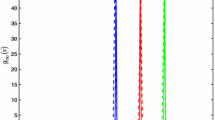Abstract
The paper treats opinion dynamics under bounded confidence when agents employ, beside an arithmetic mean, means like a geometric mean, a power mean or a random mean in aggregating opinions. The different kinds of collective dynamics resulting from these various ways of averaging are studied and compared by simulations. Particular attention is given to the random mean which is a new concept introduced in this paper. All those concrete means are just particular cases of a partial abstract mean, which also is a new concept. This comprehensive concept of averaging opinions is investigated also analytically and it is shown in particular, that the dynamics driven by it always stabilizes in a certain pattern of opinions.
Similar content being viewed by others
References
Arazy, J., Claesson, T., Janson, S. and Peetre, J. (1985). Mean and their iterations. In Proceedings of the Nineteenth Nordic Congress of Mathematics, Iceland Mathematical Society, Reykjavik, pp. 191–212.
Axelrod, R. (1997). The dissemination of culture: A model with local convergence and global polarization. Journal of Conflict Resolution, 41, 203–226.
Bénabou, R. (1996). Heterogeneity, stratifcation and growth: Macroeconomic implications of community structure and school finance. American Economic Review, 86, 584–609.
Borwein J.M. and Borwein, P.B. (1987). Pi and the AGM. A Study in Analytic Number Theory and Computational Complexity, Wiley, New York.
Ben-Naim, E., Krapivsky, P.L. and Redner, S. (2003). Bifurcations and patterns in compromise processes. Physica D, 183, 190–204.
Bullen, P.S., Mitrinović, D.S. and Vasić, P.M. (eds.) (1988). Means and Their Inequalities. D. Reidel Publication, Dordrecht.
Carlson, B.C. (1971). Algorithms involving arithmetic and geometric means. American Mathematical Monthly, 78, 496–505.
Deffuant, G., Amblard, F., Weisbuch, G. and Faure, Th. (2002). How can extremism prevail? A study based on the relative agreement interaction model. Journal of Artificial Societies and Social Simulation, 5(4), http://jasss.soc.surrey.ac.uk/5/4/1.html
Dittmer, J.C. (2001). Consensus formation under bounded confidence. Nonlinear Analysis, 47, 4615–4621.
Hardy, G.H., Littlewood, J.E. and Pólya, G. (1973). Inequalities, Cambridge University Press, Cambridge, (first published 1934)
Hegselmann, R. (2004). Opinion Dynamics – insights by radically simplifyinga models. In: D. Gillies (ed.), Laws and Models in Science, London, pp. 1–29.
Hegselmann R. and Krause, U. (2002). Opinion dynamics and bounded confidence: Models, analysis and simulation, Journal of Artificial Societies and Social Simulation 5(3). http://jass.soc.surrey.ac.uk/5/3/2.html.
Ioannides, Y.M. (2002). Nonlinear neighbourhood interactions and intergenerational transmissions of human capital. In G. Bitros and Y. Katsoulacos (eds.), Essays in Economic Theory, Growtand Labour Markets: A Festschrift in Honour of Emmanuel Drandakis, Edward Elgar, Cheltenham, pp. 75–112.
Keynes, J.M. (1973). The General Theory of Employment. In The Collected Writings of John Maynard Keynes, Vol. 14. Macmillan, London, pp. 109–123.
Krause U. and Nesemann, T. (1999). Differenzengleichungen and Diskrete Dynamische Systeme. Teubner, Stuttgart.
Krause, U. (2000). A discrete nonlinear and non-autonomous model of consensus formation. In S. Elaydi, G. Ladas, J. Popenda and J. Rakowski (eds.), Communication in Difference Equations, Gordon and Breach Publication, Amsterdam, pp. 227–236.
Krause, U. (2003). Positive particle interaction. In L. Benvenuti, A. De Santis, L. Farina (eds.), Proceeding of the First Multidisciplinarty International Symposium on Positive Systems, Rome, 2003. Springer, Berlin, pp. 199–206.
Krause, U. Collective dynamics of many-faceted agents. Preprint. http://www.bwl.uni-kiel.de/vwlinstitute/gwrp/wehia/prog-29.htm
Stauffer, D. (2001). Monte Carlo simulations of the Sznajd models. Journal of Artificial Societies and Social Simulation, 5(1), http://jasss.soc.surrey.ac.uk/5/1/4.html
Stauffer D. and Meyer-Ortmanns, H. (2004). Simulation of consensus model of Deffuant et al. on a Barabási-Albert network. cond-mat/0308231, International Journal of Modern Physics C15, No. 2, in press.
Author information
Authors and Affiliations
Corresponding author
Rights and permissions
About this article
Cite this article
Hegselmann, R., Krause, U. Opinion Dynamics Driven by Various Ways of Averaging. Comput Econ 25, 381–405 (2005). https://doi.org/10.1007/s10614-005-6296-3
Accepted:
Issue Date:
DOI: https://doi.org/10.1007/s10614-005-6296-3




